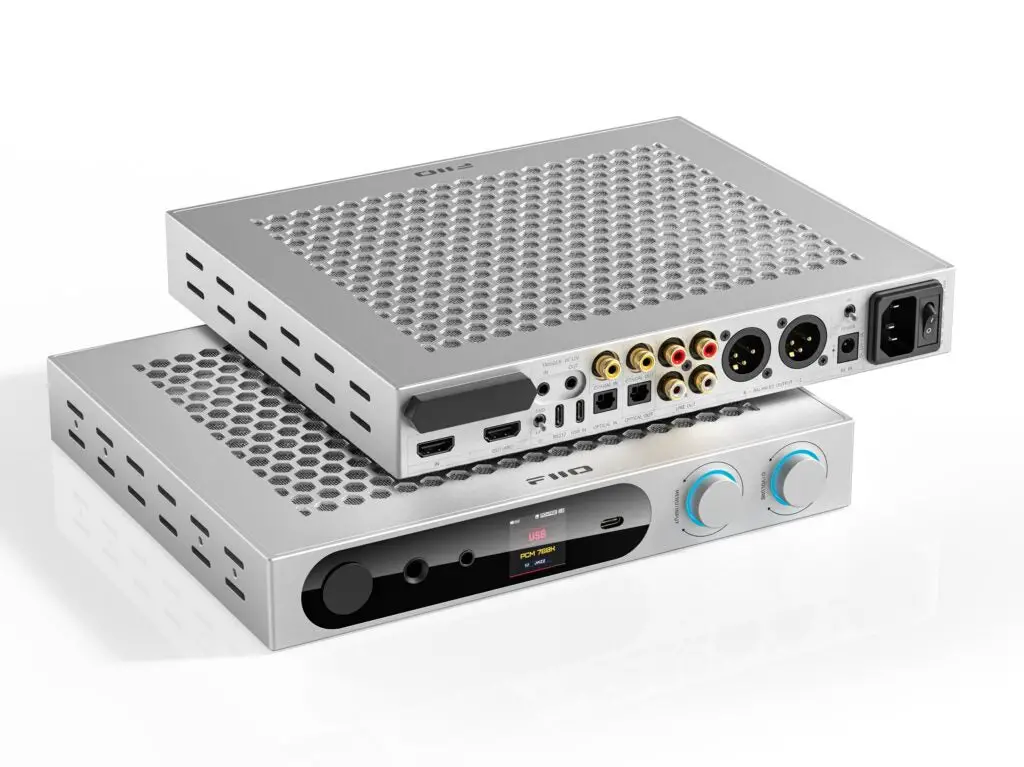Verdict
Bigger than might be ideal, specification that may well be overkill for most of us – but when it comes to making your digital audio files sound their best, the K19 competes with anything at a remotely similar price
Pros
- Remarkably insightful, poised and assertive sound
- Extraordinarily thoroughly specified
- Pleasingly built and finished
Cons
- Proves it’s possible to be over-specified
- Extended functionality makes navigating menus arduous
- Bigger than you might expect of a ‘desktop’ product
Key Features
- DACTwo 8-channel ESS ES9039SPRO DAC
Introduction
FiiO has worked its way into the position it occupies today, as a well-respected manufacturer of consumer electronics in general and audio equipment in particular, by generally going one of two ways with its products.
The first way is to offer performance comparable to the class-leaders, but at a more competitive price. The other is to match the class-leaders on price, but to pile on the features and functionality.
Which path does the K19 tread? Or is there (whisper it) a third way?
Availability
The FiiO K19 desktop headphone amplifier DAC is on sale now, and in the United Kingdom it sells for £1249. In the United States you’ll have to hand over $1299, while in Australia the going rate is AU$2049.
You’ve a fair amount of choice where headphone amp/DACs at this sort of money are concerned – but as will quickly become apparent, devices as lavishly specified as the K19 are in shorter supply…
Design
- Die-cast unibody construction
- Black or silver finishes
- 250 x 225 x 37mm (HWD)
By desktop standards, the FiiO K19 is quite a sizeable device – so it’s probably just as well the packaging includes a couple of little feet (plus a screwdriver and the screws to attach them) that allow it to stand upright – at 250 x 225 x 37mm (HWD, without feet) it’s quite tall, but at least it doesn’t take up too much desktop real estate positioned this way…
It’s a very nicely made and finished device, though – which is as it should be, given the asking price. It’s built from die-cast aluminium, and the unibody construction makes for a pleasantly seamless design. Despite its relative thinness, the construction is usefully shock-resistant – and it’s very stable on its feet too.
Four of the six sides of the chassis feature heat dissipation systems – and it doesn’t do any harm to the K19’s aesthetic appeal that its two largest sides have a honeycomb mesh design that looks pretty swish at the same time as allowing for convection heat dissipation.
On the inside, FiiO has arranged for thermally conductive material to be in direct contact with the hardware – so heat from chips is transferred to the conductive material and then on to the aluminium outer frame. The K19 gets mildly warm when it’s working – but don’t doubt it would be a lot warmer if FiiO hadn’t taken these measures.
The front of the K19 features push/turn dials covering power on/off, volume control, input selection and menu navigation – they’re both circled by lights (because this is a FiiO product, after all) that glow in one of a variety of colours depending on the file size and type the K19 is dealing with. Below there (as you look from top to bottom) there’s a crisp little (1.3-inch) display – it can rotate if you decide to change the way the K19 is orientated. Here’s when you can select input, examine some equaliser presets, set gain and maximum volume, investigate a number of filters, select the language, check for updates, and plenty more besides.
Navigation can be a bit of a trial given how small the display and the typeface on it is, but there aren’t many aspects of the K19’s performance that can’t be examined here. And there’s always the FiiO Connect app (free for iOS and Android) that can take the pain out of a lot of these operations.
Below here are the K19’s three headphone outputs. There’s an XLR4 connection behind a little cover, a 6.3mm unbalanced socket and a 4.4mm balanced alternative. Which should be sufficient in pretty much any realistic circumstance.
At the rear is where the majority of connections are – and there are plenty. As far as digital inputs go, there are digital optical and digital coaxial along with HDMI and USB-C – and there are a pair of stereo RCA analogue inputs too. Outputs run to digital optical and digital coaxial, HDMI, stereo RCA and balanced XLR.
In addition, there’s an RS232 on a USB-C slot, a 12-volt trigger loop, and both kettle-lead and DC mains adapter inputs along with an AC/DC switch. The K19 also features Bluetooth wireless connectivity, of course, with codec compatibility all the way to aptX HD and aptX LL along with LDAC.
Beyond the on-screen menus and control app, there are a further two physical interfaces. The first is an unremarkable remote control handset that covers off the major functions, and the other is a wholly remarkable 31-band PEQ.
PEQ stands for parametric EQ, and it allows the listener to use a RS232/USB-C connection to a computer (it’s available in the app too) to access a fairly intimidating 31-channel interface that can be used to directly adjust PCM signals (of between 44.1 and 192kHz) with no need of sampling rate conversion.
Unlike a graphic EQ, which simply allows a degree of boost or cut to each of its filters, PEQ allows adjustment of the centre of the frequency range, the amount of boost or cut and the sharpness of the boost or cut too. And by way of an encore, PEQ presets can be shared between K19 users.
Features
- 2 x 8-channel ESS ES9039SPRO DAC
- 8-channel THX AAA 788+ amplifier
- 32-bit/768kHz, DSD512 native resolution support
The Internet, of course, is to all intents and purposes limitless. And yet I can’t help thinking that if I discuss each and every one of the FiiO K19’s features at any kind of length, I’ll be eating into the amount of available internet space quite significantly. So it’s probably best to just touch on them…
The only reason the K19 is able to use a 31-band precision lossless PEQ is FiiO’s use of an ADI ADSP-21565 DSP chip with SHARC+ core. It’s capable of 64-bit precision floating point calculations, and ensures audio signals after PEQ are as clean and distortion-free as they were before.
The K19’s digital and analogue circuits are on separate boards with separate power supplies – there are metal shields for the DSP, DAC and headphone amplification, thanks to a compartmentalised aluminium alloy isolation design. The result is minimal crosstalk, strong isolation, minimised interference and optimal signal integrity.
In addition, the analogue audio circuit is driven by a multi-stage power supply – so there are individual power control circuits for the DAC, headphone amp and every other audio circuit.
The FiiO uses a quad-core FPGA (field programmable gate array) to handle all incoming digital signals, including Bluetooth. Once the digital processing is taken care of, the signals are passed through twin I2S channels to ensure negligible signal loss before they reach the DAC stage.
Digital-to-analogue conversion itself is handled by a couple of ESS ES9039SPRO 8-channel DAC chips – these feature fourth-gen 32-bit HyperStream architecture, and allow the K19 to handle PCM files of up to 32-bit/768kHz and DSD512 resolution. Headphone amplification, meanwhile, is taken care of by a new THX AAA 788+ 8-channel design that works in parallel – 2×2 groups make up a balanced 4-channel system. It’s driven by a high-voltage (8000mW + 8000mW) power supply that’s capable of driving pretty much any headphone you care to mention.
There’s more, of course. Plenty more. FiiO will happily talk, at length, about its low-jitter global clock management, about its ultra-low phase noise femtosecond crystal oscillators, about its AC/DC dual power supply. It makes a big deal (as it should) about its audiophile-grade components sourced from brands as credible as Panasonic (capacitors and resistors) and Neutrik (gold-plated connectors).
It’s keen for you to understand the K19 has a number of output options – PO+PRE is volume-adjustable front headphone and rear audio output, PO is volume-adjustable front headphone output, PRE OUT is volume-adjustable output from the rear sockets, and LO is fixed-level output from those rear sockets.
But I think the point is satisfactorily made by now. The FiiO K19 is a lavishly specified device, and if there’s a shortcoming in its componentry or its feature-set it’ll take a more forensic eye than mine to identify it.
Sound Quality
- Detail and dynamism to burn
- Brilliantly focused, confident sound
- Not afraid to slum it
Obviously a product as well specified as this one can fulfil a few functions. The way it’s configured means it can work on your desktop or as a source or even a preamplifier in a full-on full-size audio system – and one of the things that’s so admirable about the K19 is just how committed its performance is in any of these roles. It’s almost as commendable as its ability to raise up, rather than dunk on, lower-resolution content.
As part of a desktop set-up, it can go toe-to-toe with any price-comparable rival. With content ranging from a 320kbps MP3 file of Cherry-Coloured Funk by Cocteau Twins to a 24-bit/192kHz FLAC file of This Country by Fever Ray, and with headphones running from a pair of Grado SR80X to some Sennheiser IE900, it’s impressive in every single department.
Detail levels, for example, are approaching stratospheric. The K19 is able to extract, reveal and expertly contextualise in the finest, most transient details in a recording no matter how marginal or how deep in the mix they might be buried.
It can create a large and persuasive soundstage, with a whole lot of space from left to right for even the most complex recordings to lay themselves out coherently. And this separation and insight is never at the expense of togetherness – the FiiO facilitates a genuine sense of performance and unity that makes recordings sound of a whole.
It’s vaultingly dynamic, able to put significant distance between the quietest and the most abandoned, intense passages in the same recording. And it’s just as adept, and just as confident, where the minor harmonic and dynamic variations in, for example, a solo instrument are concerned.
The tonal balance is just so, with the sort of neutrality of approach that lets a recording get on with doing its thing rather than having the DAC overtly stick its oar in. The frequency range is integrated nicely too, with a smooth journey from the top of the frequency range to the bottom available.
And at each point of the frequency range, the K19 is positive and eloquent – it communicates eloquently through the midrange, strikes a lovely balance between substance and attack at the top end, and hits with alacrity at the bottom of the frequency range. Bass sounds are deep and forceful, but they’re properly controlled – so rhythmic expression is good.
All of the above applies when the K19 is slotted into a full-size system via the XLR outputs on its rear. But more so, somehow – when decoding a fat hi-res file and outputting to a capable power-amp-and-speaker combo, the FiiO’s game steps on again. It’s wide-open, hugely revealing and capable of a combination of substance and momentum that will have you choosing tune after tune long after you might realistically have stopped and gone to bed.
Latest deals
Should you buy it?
You’re after a desktop audio experience approaching ‘the ultimate’
No, it’s not your only choice at this sort of money – but this is one of the very best around
You’re easily intimidated
There are advantages to a 31-channel PEQ interface, most definitely – but it could conceivably be friendlier to get to grips with
Final Thoughts
I’ve been doing this sort of work for more years than I care to remember – but I don’t recall ever being quite so apprehensive about a product that should, by rights, be fairly straightforward to assess.
Happily, though, the FiiO K19 turned out to be one of those products that hides its high-performing simplicity under a bushel of acronyms and “look at me!” extended functionality. It’s just a DAC/headphone amp – don’t let it make you think otherwise – and as such is well worth consideration.
How we test
We test every desktop amplifier we review thoroughly over an extended period of time. We use industry standard tests to compare features properly. We’ll always tell you what we find. We never, ever, accept money to review a product.
Find out more about how we test in our ethics policy.
Tested with real world use
Tested across several days
You might like…
FAQs
Can I use the FiiO K19 with a TV?
The K19 features a HDMI ARC port, so you could connect it to a TV.
Full specs
UK RRP
USA RRP
AUD RRP
Manufacturer
Size (Dimensions)
Weight
ASIN
DAC
Release Date
Model Number
Driver (s)
Connectivity
Colours
Frequency Range
Audio Formats
Amplification
Remote Control
Bluetooth
Inputs
Outputs
FiiO K19
£1249
$1299
AU$2049
FiiO
225 x 36.7 x 220 MM
1.8 KG
B0D1Y6M3W6
Two ES9039SPRO
2024
K19
N/A
Bluetooth 5.1
Black, Silver
– Hz
Up to 32-bit/768kHz, DSD512
Class A
Yes
Yes
digital optical, digital coaxial, HDMI, USB-C, two stereo RCA analogue,
digital optical, digital coaxial, HDMI, stereo RCA, balanced XLR










